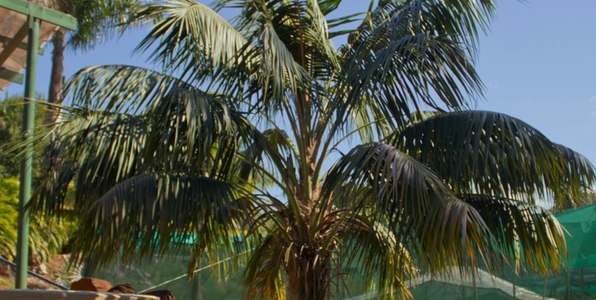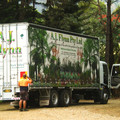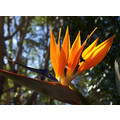Gallery
Click the thumbnails below to view image gallery:There are over 25000 species of palms in tropical, subtropical, and warm temperate climates around the world. Over 50 of these are found in Australia. These flowering plants are usually characterized by an un-branched stem (there are some exceptions) and large leaves (fronds) arranged around the top. They are extensively cultivated and widely used in landscaping due to their exotic appearance.
There are two main types of palms, palmate and pinnate. Palmate palms have large, fan-like fronds, while pinnate palms have fronds that resemble feathers. Both types of leaves are usually spirally arranged at the top of the stem, and the flowers are usually small and mature into a single-seeded fruit. While many species of palms are sold and can grow in Australia, we are going to focus on some of the more common native species:
Alexandra Palm (Archontophoenix Alexandrae)
This palm is a native along the coast of Queensland and the tip of the Cape York Peninsula. It can grow up to 30 metres, but is significantly smaller when raised in a garden. It has a pale green crown shaft and a grey to greenish-grey trunk. Its fronds are 2 to 3 metres long, with white flowers and red fruits.
Australian Cabbage Palm (Livistona Australis)
This is a popular landscaping palm due to its tolerance to various weather conditions, including frost. It is found on the eastern coast of Australia and grows up to 30 metres tall. It features a grey trunk; palmate leaves approximately 3 metres long, yellow flowers, and reddish-brown fruits.
Australian Fan Palm or Wedge Leaflet Fan (Licuala ramsayi)
This is an amazing understory rainforest palm from nth QLD where they grow to 15 metres. They will also grow south into northern NSW and can be grown further as an indoor plant. They are slow growing and need moisture and warmth. Worth the effort if you can grow one.
Bangalow Palm (Archontophoenix cunninghamiana)
This palm is very similar to an Alexandra but the trunk is thinner and the colour under the leaves is green the same as on top of the leaves .It grows to 25 metres. The Alexandra has a more silvery colour on the underside. The Bangalow is cold tolerant and ok for Melbourne, the Alex is not. They will cross pollinate if they are flowering together producing " Albangs or Bangalex's"
Black Palm (Normanya normanbyi)
This palm grows about 20 metres tall and is found in the North Queensland rainforest. It has a grey crown shaft and a light grey, smooth and slender trunk that turns almost black as the palm ages. It has 3 metre, pinnate fronds, white flowers, and yellow fruit.
Carpenteria Palm (Carpentaria acuminate)
This palm is found in the Northern Territory. It is a tall (30 metres), solitary palm that can reach maturity in 6 years under the right conditions. It has a grayish-green crown shaft and 4 metre long, dark green, pinnate, re-curved fronds. It features white and scarlet flowers.
Coconut Palm (Cocos nucifera)
This palm features a large palm head and massive coconut fruits. It is native to Queensland and tropical areas of the Western Pacific and can grow to be 35 metres tall. It has a grey trunk, cream flowers, and pinnate fronds.
Fan Palm (Livistona muelleri)
This palm grows to approximately 16 to 25 metres, but remains much smaller in gardens (3 to 4 metres). It is native to the Northern Territory and the Cape York Peninsula. It has a brown trunk, bluish-black fruit, and large, palmate fronds.
Fishtail Palm (Caryota albertii)
This palm is a large, clumping palm that grows to be 5 to 10 metres tall and approximately 4 metres across. It has a light green to grey trunk, bi-pinnate fronds with widely spaced leaf nodes, cream flowers, and dark purple fruit. Its natural habitat is the Cape York Peninsula.
Florence Falls Palm (Hydriastele wendlandiana)
This palm grows 7 to 20 metres tall in the top end of the Northern Territory and the eastern coast of the Cape York Peninsula. It has a whitish-green crown shaft and clusters of 2 to 3 slender stems rising above a dense cluster of cane-like stems. The fronds are broadly pinnate, and it has red fruits on short stalks located below the crown.
Foxtail Palm (Wodyetia bifurgata)
This palm is native to Queensland. It is suitable for tropic, subtropics, and temperate areas. It is a single trunk palm that grows to 15 metres with a pale green crown shaft and pinnate leaves. It features feathery white flowers and large bright orange fruit.
The leaves are surated at the tips and along with the arching frond, look like a foxes tail
Kentia Palm (Howea forsteriana)
This palm is native to Lord Howe Island. It is a solitary, medium-sized (up to 15 metres) palm with brown flowers and orange to red fruit. It has a brownish-grey trunk and large fronds.
Solitaire Palm (Ptychospermia elegans)
This palm grows up to 10 to 12 metres and is found in Queensland. It has a green crown shaft and a greenish-grey stem. It has a head of semi-erect, pinnate fronds and produces white flowers and bright red fruit.
Umbrella Palm (Hedyscepe canterburyana)
This palm grows up to 10 metres tall with a 1-metre long, silvery crown shaft. It has a grayish-green trunk, 3-metre long re-curved fronds, and orange to yellow flowers. Umbrella Palms also feature deep red fruits that are 4 centimeters long and densely bunched below the crown shaft.
<< Previous GUIDE TO PLANTING. This article is in the home page. | Back to Mullumbimby Palm Blog | Next >> Keeping Your Foxtails Disease Free











